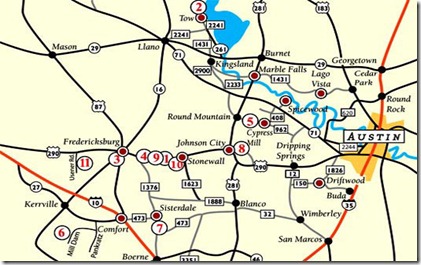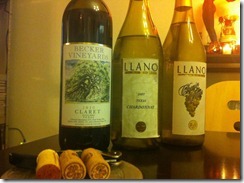Years of wine industry: 1650-present
Total area: 261,797 square miles (678,051 km2)
Size of planted vineyards: 3,200 acres (1,295 ha)
Grapes produced:
- Aglianico
- Blanc du Bois
- Cabernet Franc
- Cabernet Sauvignon
- Carignane
- Chardonnay
- Chenin Blanc
- Gewurztraminer
- Grenache
- Lenoir
- Malbec
- Merlot
- Montepulciano
- Mourvedre
- Muscadine
- Muscat
- Canelli
- Mustang
- Noble
- Norton
- Orange Muscat
- Palomino
- Petit Verdot
- Pinot Gris
- Pinot Noir
- Primitivo
- Riesling
- Roussanne
- Ruby Cabernet
- Sangiovese
- Sauvignon Blanc
- Sauvignon Musque
- Scuppernong
- Semillon
- Syrah
- Touriga Nacional
- Viognier
- Zinfandel
History:
The earliest winemaking was by the Spanish missionaries in the 1600’s in the El Paso area. It is one of the earliest wine producing regions in the USA, however it has been plagued with diseases and climatic issues from the start, so Texas wine production as we know it today did not really take hold until the 1960’s with grafting and lots of experiments by Texas A&M.
Texas’s 8 AVA’s:
Mesilla Valley AVA (1985) – West Texas. Texas’ first AVA though primarily located in New Mexico with only small parts extending into Texas.
Bell Mountain AVA (1986)- Central Texas. First AVA completely within the state of Texas. Known for its distinctive Cabernet Sauvignon grown in northern Gillespie County.
Fredericksburg in the Texas Hill Country AVA (1989) – Central Texas. Known for its Cabernet Sauvignon and Chardonnay.
Texas Hill Country AVA (1991)- Central Texas. Located just west of Austin. With over 9,000,000 acres (3,600,000 ha), it is the second-largest AVA in the United States though less than 800 acres (320 ha) are planted in grape vines.
Escondido Valley AVA (1992)- West Texas. About 32,000 acres (13,000 ha) along the Pecos River in Pecos County.
Texas High Plains AVA (1993) – North Texas. The Texas Hill country is considered the most promising up and coming AVA, specializing in the production of Cabernet Sauvignon. Covering an area of over 8,000,000 acres (3,200,000 ha), 3,500 acres (1,400 ha) are planted with 20 wineries currently producing wine.
Texas Davis Mountains AVA (1998) – West Texas. Only one winery in existence when granted AVA status in 1998. Specializes in Cabernet Sauvignon and Sauvignon Blanc.
Texoma AVA (2005) – North Texas. The Texoma region is where 19th century viticulturist Thomas Volney Munson discovered the cure for France’s phylloxera epidemic.
Wines On Today’s Show: Llano Wine: http://www.llanowine.com The simple mission of Llano Estacado, from its beginning in 1976, to its role as industry leader today, has been to embody the fabulous potential of Texas wine. This mission began with 1,300 cases of wine releases in 1977. Today, Llano Estacado is the largest, Winery in Texas.
 Chenin Blanc (NV) Escondido Valley
Chenin Blanc (NV) Escondido Valley
Oak: 100% stainless steel fermentation
Sight: Color: Pale straw-watery rim
Brightness: Star bright
Viscosity: Medium Age/Conditions: Healthy & Youthful
Nose: It is healthy…. maybe a tinge of sulfur. Lots of lime zest, lemon chiffon, ripe pear, and crisp green apple, fallowed with a chalky, limestone mineral note, and coated in honey
Pallet: This is a dry wine, with a dollop of residual sugar. There is healthy acidity, and loads of honey and pineapple notes. There is not as much mineral present in the mouth as there seemed to be in the nose. It is closer to a South African Chenin then a French Chenin.
Finish/Quality: This is an ok wine. Not as scary as I anticipated, but not mind blowing either. I feel that the RS and acid are not as balanced as they could be. That being said it is not bad for a $7.00 bottle, and it would be a good bridge for dry and sweet drinkers.
Possible Pairings: Penang Curry, or a nice stink blue cheese like St. Angur.
 Chardonnay 2007, Escondido Valley
Chardonnay 2007, Escondido Valley
Oak: None-8 Months in Stainless Steel
Sight: Color: Electric Yellow-watery Rim
Brightness: Brilliant
Viscosity: Medium
Age/Conditions: Healthy & Youthful
Nose: This leads with sweet corn, and meyer lemon zest, and hey. It’s fallowed with a chalk & sea salt not that reminds me of Chablis. Although there is a trailing finishing note of plastic shower curtain that leaves cause for concern.
Pallet: Not even close to a Chablis. There is a plastic, chemical note. There is almost no fruit and tons of acid. This wine would have benefited from MLF or Oak.
Finish: Acidic and one note.
Possible Pairings: Nothing
Becker Vineyards: www.beckervineyards.com
Becker Vineyards was established in 1992. The vineyard was planted on a site of native Mustang grapes much prized for winemaking by German neighbors and their ancestors. A few years later the Beckers planted a three acre lavender field reminiscent of the wine country of Provence, France. The 46 acres of French Vinifera vines generate 14 different available varietals, including Syrah, Petite Syrah, Sauvignon Blanc, Malbec, Petite Verdot, Cabernet Sauvignon, Cabernet Franc and Merlot.  Claret 2010, Texas Hill Country
Claret 2010, Texas Hill Country
Oak: It was carefully matured in French and American oak barrels.
Blend: 42% Cabernet Sauvignon, 34% Merlot, 5% Malbec, & 1% Cab Franc. The grapes are sourced from Texas High Plains grape growers, Laverne Newsom, & Dorothy Cooper.
Sight: Color: Garnet- Salmon rim
Brightness: Dull
Viscosity: Medium plus
Age/Conditions: Healthy & Developed
Nose: This starts with dried plum, violets, lavender, leather, and coco powder. This shows development.
Pallet : Dry, medium bodied, medium acidity, medium plus tannins, and a velvety finish. Loads of blueberries, plum, coco and violets. lovely layers.
Finish: Well done Becker estates, this reminds me of a cross between a Cahor and a Cab Blend from Paso Robles. It is fruity and elegant, with a refined rustic character.
Possible Parings: Lamb chops, Texas smoke house Brisket, or aged Gouda.
Planning a Trip: Check out the TX wine trail, it looks like a lovely wine country weekend with a touch of Southern Charm…. I’ll let you know what I think after I check it out. http://www.texaswinetrail.com/ 


